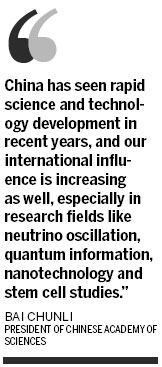Tianjin conference breeds scientific exchangel
Updated: 2012-09-19 08:07
By Cheng Yingqi (China Daily)
|
||||||||

While top scientists from developing countries attend the General Meeting of the Academy of Sciences for the Developing World in Tianjin, scientific exchanges are in full swing outside the conference room.
For example, 15 scientists and government officials from a number of countries, including Tanzania, Kenya and Egypt, attend a workshop on water quality monitoring in Nanjing, discussing ecosystem management experiences that could be replicated from China to Africa.
This is only a small part of the workshops sponsored by China.
According to the Ministry of Science and Technology, China hosted 310 science and technology workshops and sponsored more than 5,700 scientists and officials from developing countries between 2001 and 2010, mainly to provide training in advanced technologies in agriculture, medical treatment, clean energy and other fields.
As its technological abilities grow, China is strengthening its international science and technology cooperation with other developing countries.
"China has seen rapid science and technology development in recent years, and our international influence is increasing as well, especially in research fields like neutrino oscillation, quantum information, nanotechnology and stem cell studies. China is already playing the leading role.
"So it is fair to say that China leads the science and technology forefront among developing countries," said Bai Chunli, president of Chinese Academy of Sciences.
China had 1.42 million people engaged in research and development by 2010, had published 836,300 international papers from 2001 to 2011, and in 2010 filed for 293,066 patents, more than any other country in the world.
In 2009, the central government launched the China-Africa Science and Technology Partnership Program, which "sets a good example for China helping developing countries improve technological capabilities", said Jin Xiaoming, director of the international cooperation department of the Ministry of Science and Technology, at a news conference.
"I have been very impressed by the expertise and commitment of Chinese scientists, and this gives me a lot of confidence that very significant achievements will be made," said Henry Mwima, executive director of the Lake Tanganyika Authority.
Lake Tanganyika - which is shared by Burundi, the Democratic Republic of the Congo, Tanzania and Zambia - is the largest rift lake in central Africa and is famous for its biodiversity.
However, it is also one of the most fragile ecosystems in the region, thanks to the increasing population, pollution and inadequate awareness of environmental protection and climate change.
In 2011, under the United Nations Environment Programme, the Chinese Academy of Sciences' Nanjing Institute of Geography and Limnology was selected as the lead agency in an initiative to develop sustainable use of the lake's water resources.
In addition to donating equipment, Chinese scientists provided on-job training and made expeditions in the Malagarasi River watershed to collect real-time data during a visit to a partner organization, the Tanzania Fisheries Research Institute.
Ismael Kimirei, director of the Kigoma Center at that institute, said China has a larger role to play in environmental protection research.
"China has very good potential to become the giant in environmental research, especially in Africa, where sustainable environmental monitoring is precarious. And so far, China has started and is walking in the right direction," he said.
"China should also continue training African scientists in the field and aim at making the program sustainable. It is through sustainable transfer of knowledge and technology that the long-term goal of the current cooperation will be achieved."
chengyingqi@chinadaily.com.cn
(China Daily 09/19/2012 page2)

 Relief reaches isolated village
Relief reaches isolated village
 Rainfall poses new threats to quake-hit region
Rainfall poses new threats to quake-hit region
 Funerals begin for Boston bombing victims
Funerals begin for Boston bombing victims
 Quake takeaway from China's Air Force
Quake takeaway from China's Air Force
 Obama celebrates young inventors at science fair
Obama celebrates young inventors at science fair
 Earth Day marked around the world
Earth Day marked around the world
 Volunteer team helping students find sense of normalcy
Volunteer team helping students find sense of normalcy
 Ethnic groups quick to join rescue efforts
Ethnic groups quick to join rescue efforts
Most Viewed
Editor's Picks

|

|

|

|

|

|
Today's Top News
Health new priority for quake zone
Xi meets US top military officer
Japan's boats driven out of Diaoyu
China mulls online shopping legislation
Bird flu death toll rises to 22
Putin appoints new ambassador to China
Japanese ships blocked from Diaoyu Islands
Inspired by Guan, more Chinese pick up golf
US Weekly

|

|






